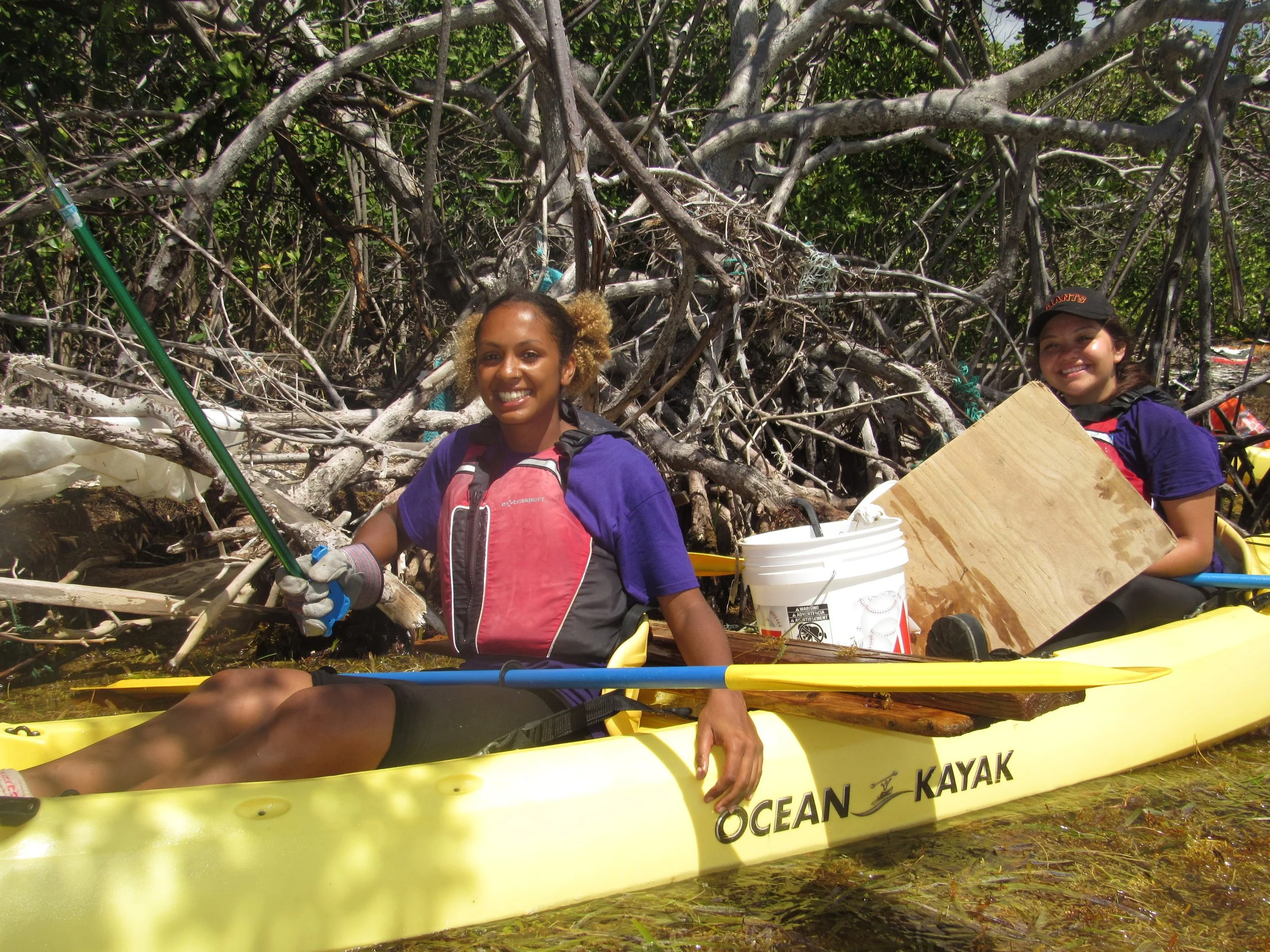The First Ever Large-Scale Mangrove Cleanup in the U.S. Virgin Islands Nets Thousands of Pounds of Debris
Guest contributor Kristin Wilson Grimes, Ph.D., Research Assistant Professor of Watershed Ecology, University of the Virgin Islands
All Hands and Heart volunteers work together to remove marine debris items from the St. Thomas East End Reserves. Photo credit: Jarvon Stout
On April 21, 2018, 126 volunteers removed more than 3,000 lbs of marine debris in the Great Mangrove Cleanup, the first, large-scale community cleanup in the St. Thomas East End Reserves (STEER), a marine protected area on the east end of St. Thomas, U.S. Virgin Islands (USVI).
These mangrove shorelines are difficult to get to which makes them especially difficult to clean, and after the twin, Category 5 Hurricanes, Irma and Maria, that hit the Territory last September, these coastlines are chockfull of marine debris. The vast majority of debris we gathered came from land-based sources (90-95% of items) and most of the items, 65-70%, were plastic. These patterns are consistent with those observed globally. The single item we collected the most of were plastic beverage bottles – 1,765 of them! For such a small area of coastline, that’s a lot. What that tells us, is that if we want to reduce marine debris in the USVI, we should be thinking about what we are drinking out of, where we are disposing of it, and where it might end up.
University of the Virgin Islands Masters of Marine & Environmental Science student volunteers, Danielle Lasseigne and Zola Roper, sort and count marine debris items at the Great Mangrove Cleanup. Photo credit: Jarvon Stout
All Hands and Heart volunteers work together to remove marine debris items from the St. Thomas East End Reserves. Photo credit: Jarvon Stout
The USVI doesn’t have widespread recycling programs, so items from the Cleanup that could be re-used were – fenders, buoys, and pieces of wood, for example. Metal was recycled for scrap and hard plastics (like all those plastic bottles) were recycled through the Virgin Islands Department of Planning & Natural Resources (DPNR) Division of Coastal Zone Management’s recycling partnership with Terracycle, run by DPNR Education and Outreach Coordinator, Kristina Edwards.
All Hands and Heart volunteers work together to remove marine debris items from the St. Thomas East End Reserves. Photo credit: Jarvon Stout
Participating in the Cleanup was a team from the University of the Virgin Islands (UVI) including members of the Center for Marine & Environmental Studies (CMES), Masters of Marine and Environmental Studies (MMES) students, and UVI undergraduates. Nearly 50 individuals from All Hands and Hearts, a volunteer organization assisting in hurricane recovery in the Territory, also participated in the cleanup, as did members of the Virgin Islands Established Program to Stimulate Competitive Research (VI-EPSCoR), the Virgin Islands Marine Advisory Service (VIMAS), Federal Emergency Management Agency (FEMA), local agencies (DPNR Division of Coastal Zone Management, DPNR Division of Environmental Enforcement, and the Virgin Islands Waste Management Authority); and other local non-profits (USVI Marine Rebuild Fund, Perfect Heart, Blue Flag, Camp Umoja, and the Environmental Association of St. Thomas, among others).
The Cleanup was sponsored by the NOAA Marine Debris Program and the NOAA Coral Reef Conservation Program, in partnership with VI-EPSCoR, VIMAS, UVI CMES, DPNR Div. of Coastal Zone Management, USVI Marine Rebuild Fund, and three local businesses (Virgin Islands Ecotours, Pizza Pi, and Custom Builders).
"It was only by combining our efforts, that we were able to achieve such a big impact. It shows what we can accomplish when we work together. For as much as we were able to remove, there’s a lot more to go", said Virgin Islands Marine Advisory Service St. Thomas/St. John Coordinator, Mr. Howard Forbes, Jr. VIMAS is University of Puerto Rico Sea Grant’s extension arm in the U.S. Virgin Islands.
Partners hope to make the Great Mangrove Cleanup an annual event.
The top 10 items collected
1,765 plastic beverage containers
1,000 misc. plastic pieces
585 foam pieces
417 aluminum beverage cans
359 other plastic bottles
328 plastic bags
307 glass bottles
298 pieces of rope
265 plastic cups
201 plastic food containers
Other weird finds
55 shoes
1 pool noodle
2 fire extinguishers
11 snorkels
32 balls




